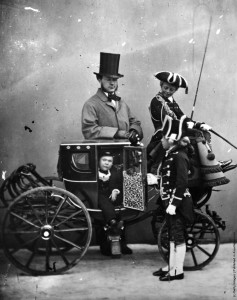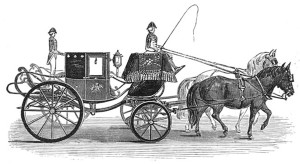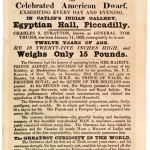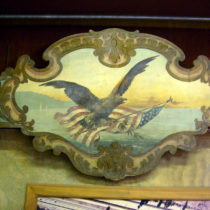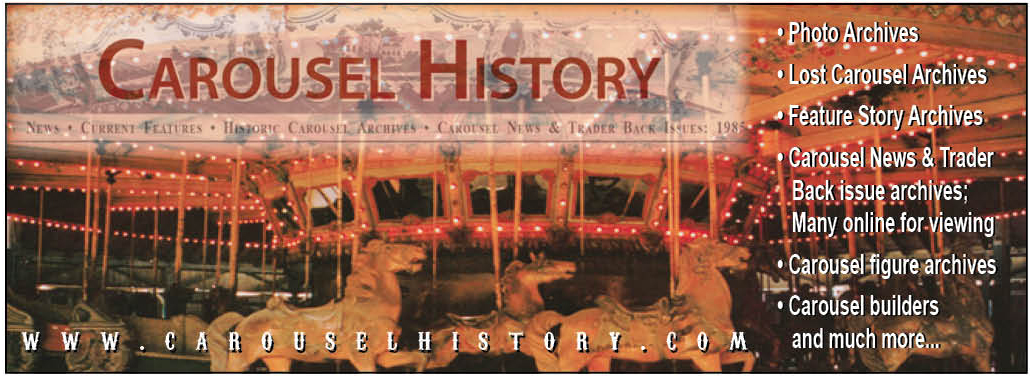Description
On the 1844 Tom Thumb Carriage –
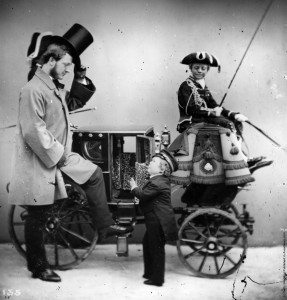 “Mr. S. Beaton, of No. 16, Denmark-street, Soho, has just built for his Generalship an elegant dress chariot, suitable to the dimensions of the hero. The body of the chariot is twenty inches high, and eleven inches wide. Upon the door panels are emblazoned the General’s arms, Britannia and the Goddess of Liberty, supported by the British Lion and American Eagle; crest, the Rising Sun and American flags; the motto, “Go-a-head!” The carriage will be drawn by a pair of Shetland ponies, which have been purchased of Mr. Batty, of Astley’s Royal Amphitheatre.”
“Mr. S. Beaton, of No. 16, Denmark-street, Soho, has just built for his Generalship an elegant dress chariot, suitable to the dimensions of the hero. The body of the chariot is twenty inches high, and eleven inches wide. Upon the door panels are emblazoned the General’s arms, Britannia and the Goddess of Liberty, supported by the British Lion and American Eagle; crest, the Rising Sun and American flags; the motto, “Go-a-head!” The carriage will be drawn by a pair of Shetland ponies, which have been purchased of Mr. Batty, of Astley’s Royal Amphitheatre.”
On the Live Tom Thumb –
The embodiment of the fairy tale character, Tom Thumb, would be Charles Sherwood Stratton (January 4, 1838 – July 15, 1883), better known by his stage name “General Tom Thumb”. Born in Bridgeport, CT, Stratton was a dwarf who achieved great fame as a performer under circus pioneer P.T. Barnum.
In 1862, at the age of 24, Stratton had grown to stand 2 feet 11 inches tall. In 1863, he famously took a wife, Lavinia Warren. Warren was born at Middleborough, Massachusetts as Mercy Lavinia Warren Bump, a descendant of a French Catholic family named Bonpasse, of Governor Thomas Mayhew, and five Mayflower passengers: John Billington, Francis Cooke, Edward Doty, Stephen Hopkins*, and Richard Warren — New England families which intermarried many times over.
*(And thus, interestingly, I am related to Tom Thumb’s wife).
“General Tom Thumb, a dwarf, was exhibited in the Music Hall, Newcastle, on this and the four following days, and there, as elsewhere, drew immense crowds of spectators. The child, who was 25 inches in height and weighed only about 15 lb, was drawn about the streets in a very handsome chariot of most diminutive dimensions. He was represented to be in his thirteenth year, by his exhibitor, Mr. Barnum, one of the most accomplished social humbugs existing at that time, although, in reality, he was only in his fifth year, which Mr. Barnum unblushingly acknowledged, afterwards, when lecturing in Newcastle on “Humbug.””
– Courtesy of Thomas Fordyce writing a report from this day in history, 11th November 1844.
https://en.wikipedia.org/wiki/General_Tom_Thumb
On the Fairy Tale Tom Thumb –
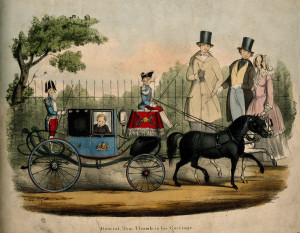 “Tom Thumb is a character of English folklore. The History of Tom Thumb was published in 1621, and has the distinction of being the first fairy tale printed in English. Tom is no bigger than his father’s thumb, and his adventures include being swallowed by a cow, tangling with giants, and becoming a favorite of King Arthur. The earliest allusions to Tom occur in various 16th century works such as Reginald Scot’s Discovery of Witchcraft (1584) where Tom is cited as one of the supernatural folk employed by servant maids to frighten children.
“Tom Thumb is a character of English folklore. The History of Tom Thumb was published in 1621, and has the distinction of being the first fairy tale printed in English. Tom is no bigger than his father’s thumb, and his adventures include being swallowed by a cow, tangling with giants, and becoming a favorite of King Arthur. The earliest allusions to Tom occur in various 16th century works such as Reginald Scot’s Discovery of Witchcraft (1584) where Tom is cited as one of the supernatural folk employed by servant maids to frighten children.
Aside from his own tale, Tom figures in Henry Fielding’s play Tom Thumb, a companion piece to his The Author’s Farce. It was later expanded into a single piece titled The Tragedy of Tragedies, or the History of Tom Thumb the Great.
In the middle 18th century, books began to be published specifically for children (some with their authorship attributed to “Tommy Thumb”) and, by the middle 19th century, Tom was a fixture of the nursery library. Charlotte Yonge cleansed questionable passages and the tale took on moral overtones. Dinah Mulock however refrained from scrubbing the tale of its vulgarities. Tom Thumb’s story has been adapted to several films including the 1958 George Pal musical tom thumb starring Russ Tamblyn. Tiny folkloric characters like Tom are known in cultures around the world”. – Wikipedia



